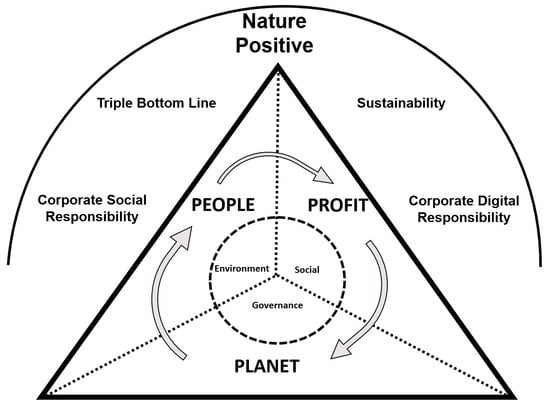Nature Positive in Business
Definition
:1. Introduction
2. Genesis and History
3. Discovery
4. Current Status
4.1. Organisational Perspectives
4.2. Company Initiatives
5. Evaluation
6. Conclusion and Future Directions
Author Contributions
Funding
Conflicts of Interest
References
- Davoudi, L.; McKenna, C.; Olegario, R. The historical role of the corporation in society. J. Br. Acad. 2018, 6, 17–47. [Google Scholar] [CrossRef]
- Bowen, H.R. Social Responsibility of the Businessman; Harper and Row: New York, NY, USA, 1953. [Google Scholar]
- Elkington, J. 25 Years Ago I Coined the Phrase ‘Triple Bottom Line’: Here’s Why It’s Time to Rethink It. Harv. Bus. Rev. 2018, 6, 2–5. Available online: https://hbr.org/2018/06/25-years-ago-i-coined-the-phrase-triple-bottom-line-heres-why-im-giving-up-on-it (accessed on 2 April 2024).
- Byrne, D. What is the history of ESG? Corporate Governance Institute. 2024. Available online: https://www.thecorporategovernanceinstitute.com/insights/lexicon/what-is-the-history-of-esg/#:~:text=A%202004%20report%20from%20the,to%20embrace%20ESG%20long%2Dterm (accessed on 15 April 2024).
- Wynn, M.; Jones, P. Corporate responsibility in the digital era. Information 2023, 14, 324. [Google Scholar] [CrossRef]
- Lambertini, M.; Zabey, E. Comment: Nature Positive Has Hit the Mainstream. We Need to Ensure It Delivers Transformation Not Greenwashing. Reuters, 28 November 2023. Available online: https://www.reuters.com/sustainability/land-use-biodiversity/comment-nature-positive-has-hit-mainstream-we-need-ensure-it-delivers-2023-11-28/ (accessed on 14 February 2024).
- Golnaraghi, M.; Mellot, A. Nature and the Insurance Industry: Taking Action towards a Nature Positive Economy; The Geneva Association: Zurich, Switzerland, 2022; Available online: https://www.genevaassociation.org/sites/default/files/2022-11/nature_and_insurance_summary.pdf (accessed on 21 April 2024).
- Jones, P. Nature Positive Tourism. Athens J. Tour. 2024, 11, 95–108. [Google Scholar] [CrossRef]
- World Business Council for Sustainable Development. What Does Nature Positive Mean for Business. 2021. Available online: https://www.wbcsd.org/contentwbc/download/13439/196253/1 (accessed on 14 February 2024).
- Waughray, D.K.N. Why Being ‘Nature Positive’ Is the Key to Our Future. Greenbiz, 1 July 2021. Available online: https://www.greenbiz.com/article/why-being-nature-positive-key-our-future (accessed on 7 April 2024).
- Greenen, M.; Butterworth, T. The Path Toward a Nature Positive Business. Cutter, 5 December 2022. Available online: https://www.cutter.com/article/path-toward-nature-positive-business (accessed on 7 April 2024).
- Martin, E.; Vidal, A. Moving beyond Rhetoric: To Build a Nature-Positive Economy, Focus on Nature-Supportive Action. Quantis, 4 April 2023. Available online: https://quantis.com/news/defining-nature-positive-business/ (accessed on 7 April 2024).
- Global Commons Alliance. What is ‘Nature Positive’ and Why Is It the Key to Our Future? Available online: https://globalcommonsalliance.org/news/what-is-nature-positive-and-why-is-it-the-key-to-our-future/ (accessed on 7 April 2024).
- World Wildlife Fund. Nature-Positive Business. 2024. Available online: https://www.worldwildlife.org/pages/nature-positive-business#:~:text=Nature%2Dpositive%20is%20defined%20as,on%20the%20path%20of%20recovery (accessed on 11 April 2024).
- Yang, D. The World’s Next Big Challenge Is Becoming Nature Positive. 2023. Available online: https://www.mckinsey.com/~/media/mckinsey/email/rethink/2023/04/2023-04-26d.html (accessed on 10 April 2024).
- Maron, M.; Quétier, F.; Sarmiento, M.; ten Kate, K.; Evans, M.C.; Bull, J.W.; Jones, J.P.G.; zu Ermgassen, S.O.; Millner-Gulland, E.J.; Brownlie, S.; et al. Nature positive must incorporate, not undermine, the mitigation hierarchy. Nat. Ecol. Evol. 2024, 8, 14–17. [Google Scholar] [CrossRef] [PubMed]
- United Nations Environment Programme. Facts about the Nature Crisis. 2023. Available online: https://www.unep.org/ar/node/32223#:~:text=(Becoming%20Generation%20Restoration%2C%20UNEP),85%20percent%20of%20wetland%20areas (accessed on 24 November 2023).
- United Nations Environment Programme. Five Drivers of the Nature Crisis. 2023. Available online: https://www.unep.org/news-and-stories/story/five-drivers-nature-crisis#:~:text=The%20biggest%20driver%20of%20biodiversity,conversion%20to%20other%20land%20uses (accessed on 10 April 2024.).
- PWC. Nature Strategy Handbook. 2023. Available online: https://nowfornature.org/read-the-handbook/ (accessed on 14 February 2024).
- World Economic Forum. Our Mission, 2024. Available online: https://www.weforum.org/about/world-economic-forum/#:~:text=The%20World%20Economic%20Forum%20is,initiatives%20for%20cooperation%20and%20progress (accessed on 20 February 2024).
- IUCN. Nature Positive for Business: Developing a Positive Approach, 2023. Available online: https://portals.iucn.org/library/sites/library/files/documents/2023-023-En.pdf (accessed on 14 February 2024).
- Unilever. Leading in the Next Era of Corporate Sustainability, 2024. Available online: https://www.unilever.co.uk/sustainability/ (accessed on 18 April 2024).
- Unilever. Regenerating Nature, 2024. Available online: https://www.unilever.com/sustainability/nature/regenerating-nature/ (accessed on 21 April 2024).
- Gucci Equilibrium. Impact Report, 2022. Available online: https://equilibrium.gucci.com/impactreport-2021/ (accessed on 26 February 2024).
- Gucci Equilibrium. Gucci’s Nature-Positive Vision: From the Ground up to Collections, 2022. Available online: https://equilibrium.gucci.com/guccis-nature-positive-vision-from-the-ground-up-to-collections/ (accessed on 26 February 2024).
- Milner-Gulland, E.J. Don’t dilute the term Nature Positive. Nat. Ecol. Evol. 2022, 6, 1243–1244. [Google Scholar] [CrossRef] [PubMed]
- World Economic Forum. Why It’s Time to Make Your Business Nature Positive. 2023. Available online: https://www.weforum.org/agenda/2023/02/bringing-nature-positivity-to-your-boardroom/ (accessed on 10 April 2024).
- Green Biz. Is Greenwashing Already Threatening to Uproot Nature Positive Initiatives. 2024. Available online: https://www.greenbiz.com/article/greenwashing-already-threatening-uproot-nature-positive-initiatives (accessed on 10 April 2024).
- Vlieg, A.M.; Moazzem, S.; Naiker, D.; Jones, D.G. Quantifying Nature Positive. Preprints 2022, 2022010012. Available online: https://www.preprints.org/manuscript/202201.0012/v3 (accessed on 20 April 2024).
- Mace, M. Is Nature-Positive Business a Possibility or Paradox? Edie scope3 Emissions Workshops, 15 June 2023. Available online: https://www.edie.net/is-nature-positive-business-a-possibility-or-paradox/ (accessed on 9 April 2024).
- Nature Positive Economy Cooperative Research Centre. Announcing Val. Ai as Nature Positive Economy CRC’s First Partner. 2023. Available online: https://naturepositivecrc.com.au/announcing-val-ai-as-nature-positive-economy-crcs-first-partner/ (accessed on 10 April 2024).
- Cuckston, T. Reimaging Business and Management as Force for a Nature Positive future. Preprint. 2022. Available online: https://www.researchgate.net/publication/364820217_Reimagining_Business_and_Management_as_a_Force_for_a_Nature-Positive_Future (accessed on 19 April 2024).
- White, T.B.; Petrovan, S.O.; Bennun, L.A.; Butterworth, T.; Christie, A.P.; Downey, H.; Hunter, S.B.; Jobson, B.R.; zu Ermgassen, S.O.; Sutherland, W.J. Principles for using evidence to improve biodiversity impact mitigation by business. Bus. Strategy Environ. 2023, 32, 4719–4733. Available online: https://onlinelibrary.wiley.com/doi/10.1002/bse.3389 (accessed on 21 April 2024). [CrossRef]

Disclaimer/Publisher’s Note: The statements, opinions and data contained in all publications are solely those of the individual author(s) and contributor(s) and not of MDPI and/or the editor(s). MDPI and/or the editor(s) disclaim responsibility for any injury to people or property resulting from any ideas, methods, instructions or products referred to in the content. |
© 2024 by the authors. Licensee MDPI, Basel, Switzerland. This article is an open access article distributed under the terms and conditions of the Creative Commons Attribution (CC BY) license (https://creativecommons.org/licenses/by/4.0/).
Share and Cite
Jones, P.; Wynn, M. Nature Positive in Business. Encyclopedia 2024, 4, 776-784. https://doi.org/10.3390/encyclopedia4020049
Jones P, Wynn M. Nature Positive in Business. Encyclopedia. 2024; 4(2):776-784. https://doi.org/10.3390/encyclopedia4020049
Chicago/Turabian StyleJones, Peter, and Martin Wynn. 2024. "Nature Positive in Business" Encyclopedia 4, no. 2: 776-784. https://doi.org/10.3390/encyclopedia4020049







